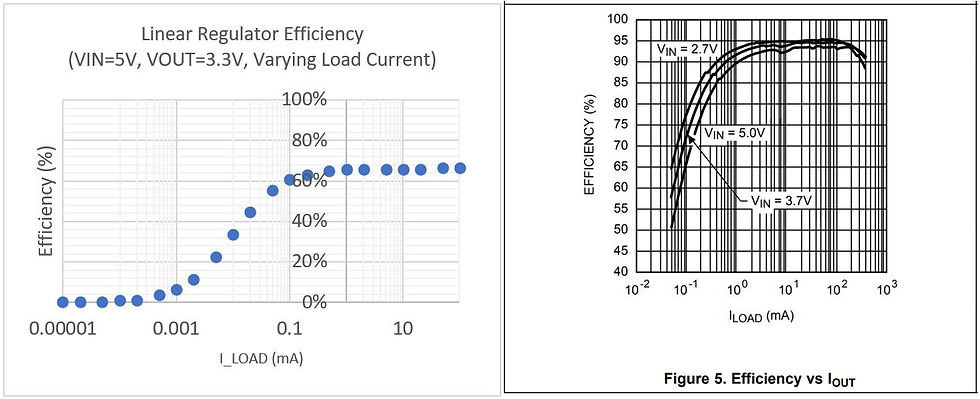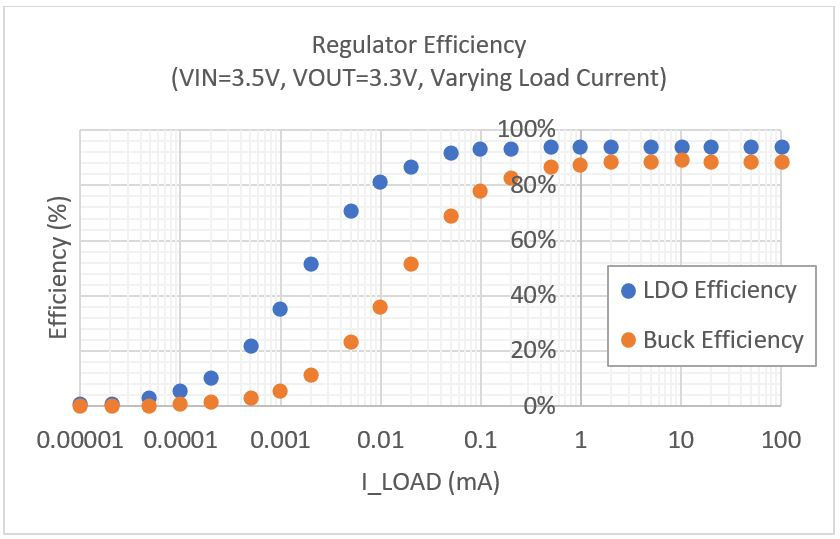When is an LDO More Efficient Than a Switching Power Converter?
- Rachel Chaney

- Jan 14, 2020
- 4 min read
Updated: Jan 7, 2021
Power: When is an LDO More Efficient Than a Switching Power Converter?
When you have one voltage (5V from a USB connection for instance), and you need to power a component at a lesser voltage (3.3V for a microcontroller for instance), you have a choice to make: do you use a switching converter or a linear regulator to generate the lesser voltage? One criterium to consider when making this decision is efficiency.
Switching power supplies are often the most efficient choice. A switching power supply, for instance, a buck converter, uses pulse width modulation to generate a DC output voltage. When the difference between input and output voltage is relatively great and the output current is relatively high, switching converters are likely the most efficient choice. When the output voltage must be isolated, inverted, or greater than the input voltage, switching converters are probably the only choice.
Linear regulators are typically smaller, cheaper, quieter, and simpler to implement compared to switching converters. These features make linear regulators preferable in certain applications. They are thought of as inefficient in comparison to switching converters. This is true in many, but not all, cases. In fact, there are certain cases where a linear regulator is as efficient (or more efficient!) than a buck converter. Linear regulators are an efficient choice when the current is relatively low, or the voltage drop is relatively small.
Small Load Current (Light Load State)
Switching power supplies are a good choice when the output power is much greater than the power dissipated by the switching circuit (which varies based on switching frequency, operating current for active hardware, RDSON of switches, rise and fall time of switching node, DC resistance of power inductor, commutation current paths, stray capacitance, etc.). For reference, a great source for calculating buck losses is located here. These losses set the efficiency of the buck converter.
A buck converter becomes less efficient when the output power is about the same as the power required to control and operate the circuit; some active losses in the circuit are unaffected by reduced output current. Modern switching regulator chips will implement a light-load or cycle-skipping feature to improve efficiency under light loads. One downside of this mode is an increase in voltage ripple; skipping cycles results in lower effective switching frequency, which causes lower frequency output voltage ripple and requires output filtering with a lower bandwidth (larger value passive filtering components).
Compare the graphs below to see the difference between a linear regulator (Micrel MIC5365-3.3) and a buck converter (Texas Instruments LM3670), used to regulate 3.3V from a 5V supply. If the load draws a current of 100uA, both circuits operate at about 60% efficiency. For lesser load currents, efficiency is about the same.

Note that the power dissipation in either a linear regulator or a switching power supply causes the junction temperature inside the integrated circuits to rise. It is vital to keep the junction temperature within published operating specifications; this may require a heatsink or other cooling device. By performing vital calculations during electrical design, a heatsink can be avoided or specified in advance to streamline the product design flow.
Small Voltage Difference Between VIN and VLOAD
A linear regulator acts like a current-controlled resistor, dropping whatever voltage is necessary to get to the "right" output voltage for whatever current required by the load (within a specified range). The power dissipation in the linear regulator is dominated by this "current-controlled resistor." When the voltage supply is nearly the right voltage for a load, the power dissipation is relatively small.
Look at the graph below to see the difference between a linear regulator (Micrel MIC5365-3.3) and a buck converter (Texas Instruments LM3670), used to regulate 3.3V from a 3.5V supply. In this case, the low dropout of the linear regulator means it's more efficient across all load currents. This is only possible when using a low dropout linear regulator near its dropout voltage.

Look at the graph below to see the effect of dropout voltage on efficiency for the same load current (for the same power circuits explored above). As the voltage drop across the linear regulator increases, the efficiency decreases linearly, as expected. There is a limit where the buck converter and the linear regulator have the same efficiency; this limit depends on the specific calculation of losses in the buck converter and the specifications of the linear regulator.

While the buck converter is a more efficient and versatile choice when the difference between input and output voltage is relatively great or the output current is relatively high. Under light load conditions or when using a low dropout feature, a linear regulator can provide similar (or better!) efficiency in a simpler, cheaper, and physically smaller package than a switching power supply can.
NK Labs, LLC is a product development engineering firm in Cambridge, MA. We have broad experience in the design of consumer electronics, robotics, and other innovative products. Please consider us for your next engineering design project!



Comments